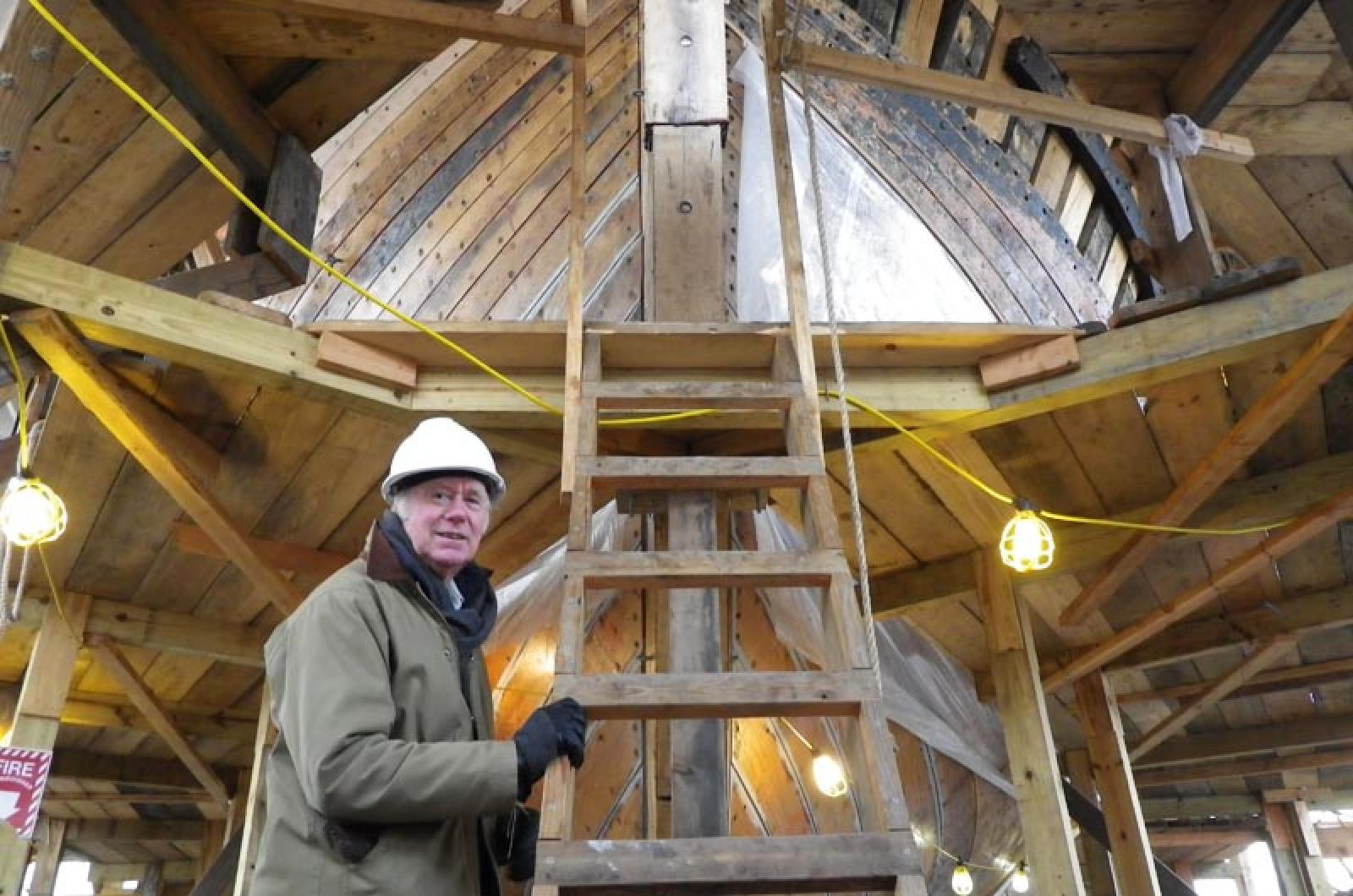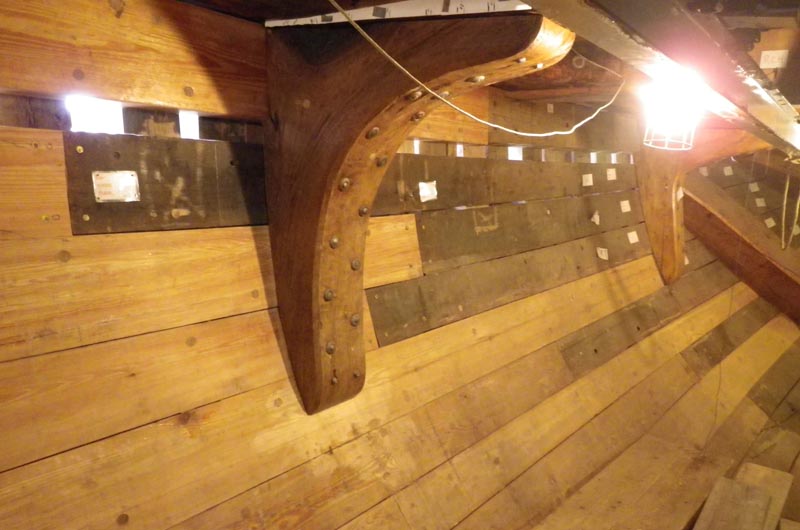She once took her place among 2,700 whaling ships crisscrossing the world as part of the flourishing whaling industry. She was distinguished over the years by her luck — avoiding fatal brushes with confederate raiders, typhoons and coral reefs — and her profitability. In 80 years, she hauled in more than 54,000 barrels of precious oil.
Now nearly 173 years after she first set sail, the Charles W. Morgan has survived to earn a new distinction. She is the last whaling ship, a valuable collection of wood and history that represents an industry and an era now gone.
Whaling tells a story about “we as a nation,” longtime Vineyarder Matthew Stackpole said Wednesday evening at a Sail Martha’s Vineyard dinner lecture. “It has so many aspects of it that help us better understand our soul, our story as a nation — in terms of the character we have, our values, in terms of being risk takers and explorers. And all of that was required for this industry to be successful.”
And the Charles W. Morgan, he said, “is the only vessel left to represent that entire story, a story that goes way back to the beginning of the country.” The Black Dog Tavern was filled Wednesday with those who braved the snow to hear Mr. Stackpole tell some of the story, which weaves in history and science, business and technology, the Vineyard and distant countries.
Mr. Stackpole served as executive director of the Martha’s Vineyard Museum for eight years and is a former president of Sail Martha’s Vineyard. He is now a historian and major gifts officer with Mystic Seaport, which is restoring the Charles W. Morgan.
Mr. Stackpole “is a treasure to the Island and to the preservation of all things nautical . . . and that’s part of what Sail MV is all about,” board member Paul Schneider said as he introduced Mr. Stackpole to the room. During his presentation, Mr. Stackpole noted that a picture of the Morgan was placed behind him on the wall.
American whaling ships sailed on 14,864 voyages as part of an industry that lasted more than 250 years. Money generated by whaling “went into our growing economy,” Mr. Stackpole said, and was a force in the industrial revolution, westward expansion, advances in technology and building American railroads. Whaling was the first industry the United States dominated internationally, he added.
Sperm whales were the sought after catch, with sperm oil valued as a lubricant and an illuminant.
The Charles W. Morgan first set sail from New Bedford on Wednesday, July 21, 1841. The ship was built at the J&Z Hillman Brothers Shipyard, owned by Jethro and Zachariah Hillman of Chilmark.
The Morgan’s first voyage lasted three years, three months and 27 days. The ship visited every ocean, traveling from the Azores to the coasts of Africa and South America to the Gulf of Alaska.
They caught their first whale (one of 70 caught over almost 40 months) on Dec. 13, 1841, near the equator.
The Morgan made 37 voyages in 80 years. “They went everywhere, and they went over and over again,” Mr. Stackpole said. Over time, the crew started to change, as crew came aboard from ports of call.

The history of the ship is such that Charles W. Morgan himself, who managed many whaling vessels and invested in a spermaceti candleworks, a foundry and a bank is just a small piece of the story. Mr. Morgan owned the principal part of the ship.
Mr. Morgan’s journal and ship logs contributed to the Morgan being the most-documented ship in the country besides the U.S. Constitution, Mr. Stackpole said. He showed a picture of Mr. Morgan’s diary entry from the day of the ship’s maiden voyage, written in neat cursive, and read along:
“A fine warm day but very dry. This morning at 10 o’clock my elegant new ship was launched beautifully from Messrs. Hillman’s yard — and in the presence of both half the town and a great show of ladies . . .”
“I love that because who says Quakers aren’t looking around,” Mr. Stackpole interjected. He continued reading:
“She looks beautifully on the water. She was copper-bottomed on the stocks. She is to be commanded by Captain Thomas Norton.”
Mr. Norton was one of many Vineyard connections to the ship. Besides Mr. Norton, who hailed from Edgartown, several other of those who served as captain of the Charles W. Morgan called the Vineyard home.
Others on board that first voyage also had Vineyard names and home towns: Athearns and Coffins, Manters and Mayhews, most in their late teens, set sail with the Charles W. Morgan.
“May kind Neptune protect us with pleasant gales and may we be successful in catching sperm whales,” second mate James Osborn (also a Vineyarder) wrote in his log of the first voyage.
Whether to Neptune’s credit or not, both of Mr. Osborn’s wishes were granted.
“This is the part that startles me,” Mr. Stackpole said. The total value of sperm oil, whale oil and baleen bought back on the Morgan was more than $1.4 million in the 19th century. The contemporary equivalent would be $32.8 million.
The total haul was 54,483 barrels of oil and more than 152,000 pounds of whale bone.
Luck, too, was on the Morgan’s side. She survived harrowing brushes with coral reefs, would-be attackers, a typhoon, World War I and the hurricane of 1938, and was threatened by a nearby steamer that caught on fire at the shipyard. She avoided confederate raiders during the Civil War.
And of course, she’s still standing. After being saved by a philanthropist who took her to his home, the Charles W. Morgan found a home at the Mystic Seaport, where she is being restored.
“The great thing about a wooden boat,” Mr. Stackpole said, “is that it is infinitely replaceable.”
With no plans or records from the original ship, the reconstruction was like an archeological dig, with careful x-rays and documentation, Mr. Stackpole said. The lowest pieces of the ship were preserved because they were in the saltwater so much, but others parts of the ship needed replacing.
In the end, up to 18 per cent of the ship is the “original fabric,” Mr. Stackpole said.
She was launched again in summer 2013, on the 172nd anniversary of her maiden launch. Charles W. Morgan’s great-great-great granddaughter broke a bottle filled with water from New Bedford and every ocean over the boat. “The ship was christened with water from places she’d already been,” Mr. Stackpole said.
This summer, the restored Charles W. Morgan will set sail on her 38th voyage, a three-month tour that will raise the visibility of maritime history, Mr. Stackpole said. There will be stops in Newport, New Bedford, Provincetown, Provincetown and Boston.
She will sail in Vineyard waters around June 18, coming to Vineyard Haven for a three-day visit.
On this voyage, Mr. Stackpole said, her cargo is history. Also on board will be nine replica wooden whaleboats, including one built by Gannon and Benjamin in Vineyard Haven.
“There are no color photos of a whaleship under sail and we’re going to change that,” Mr. Stackpole said. “Boy, are we going to have an amazing time.”









Comments (6)
Comments
Comment policy »